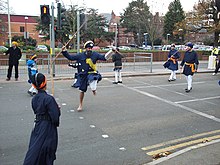Gatka

Gatka demonstration in Bedford, England (2007)
|
|
| Focus | Weaponry |
|---|---|
| Country of origin |
|
| Famous practitioners |
Guru Hargobind Emperor Akbar Guru Gobind Singh Bhai Daya Singh Sahibzada Ajit Singh Sahibzada Jujhar Singh Kapur Singh Mai Bhago Baba Deep Singh Phula Singh |
| Olympic sport | No |
Gatka (Punjabi: ਗਤਕਾ gatkā) is a traditional South Asian form of combat-training, developed by Sikhs, in which wooden sticks are used to simulate swords in sparring matches. In modern usage, it commonly refers to the northwestern Indian martial arts, which should more properly be called shastara vidiyā (ਸ਼ਸਤਰ ਵਿਦਿਆ, from Sanskrit shastra-vidya or "science of weapons"). Attacks and counterattacks vary from one community to another but the basic techniques are the same. This article will primarily use the extended definition of gatka, making it synonymous with shastara-vidiya.
Gatka can be practiced either as a sport (khel) or ritual (rasmi). The sport form is played by two opponents wielding wooden staves called gatka. These sticks may be paired with a shield. Points are scored for making contact with the stick. The other weapons are not used for full-contact sparring, but their techniques are taught through forms training. The ritual form is purely for demonstration and is performed to music during occasions such as weddings, or as part of a theatrical performance like the chhau dance. A practitioner of gatka is called a gatkabaj while a teacher is addressed as Guru or Gurudev.
Sikhs and Punjabis in general were known throughout South Asia for their stature and comparatively large build. Guru Angad Dev, taught followers to train the body physically, mentally and spiritually, encouraging the practice of martial arts. One of Guru Nanak's early disciples, Baba Buddha, taught the boy who would eventually become the sixth Sikh patriarch, Guru Hargobind.
Guru Hargobind founded the original Sikh fighting school, the Ranjit Akhara (lit. "invincible training hall") at Amritsar, with its armed force known as the Akal Sena or "immortal army". He propagated the theory of the warrior-saint (miri-piri) and emphasized the need to practice fighting for self-defence against the Mughal rulers due to growing animosities. The Guru began the practice of laying out weapons in the form of a lotus flower for saluting and worshipping before a training session. The weapons were a straight khanda (sword) representing Mahakala and a curved talwar (sabre) representing Bhavani. The Prem Sumārag tells that these are the katara (dagger), churi (knife), jamadār (poniard), kirpan (sword), kamān (bow), and dhāla (shield).
...
Wikipedia
